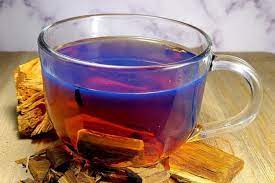Palo Azul is a traditional herbal tea made from the bark of the Eysenhardtia polystachya tree, native to Mexico and parts of Central America. Known for its unique blue tint when brewed, this tea has been valued for centuries for its potential health benefits and cultural significance. Today, it is gaining popularity worldwide as a natural detox drink and a caffeine-free wellness beverage. From aiding hydration to supporting kidney function, Palo Azul offers both tradition and modern appeal.
What is Palo Azul?
The name “Palo Azul” translates to “blue stick” in Spanish, referring to the bluish hue the tea produces under certain light conditions. Traditionally, it has been consumed in Mexican folk medicine to promote urinary tract health and general well-being. The bark is typically boiled in water to extract its beneficial compounds, creating a mildly sweet, earthy tea that can be enjoyed hot or cold.
History and Cultural Significance
Palo Azul has deep roots in indigenous and colonial-era traditions. Native peoples used it not only as a beverage but also as a ceremonial drink for purification. Over time, it became a household remedy across rural Mexico. Today, it is sold in herbal markets, health stores, and online wellness shops, bridging cultural heritage and modern health trends.
Potential Health Benefits
While scientific research is still ongoing, Palo Azul has been linked to several possible benefits based on traditional use and preliminary studies.
Supports Kidney and Urinary Tract Health
Palo Azul has been traditionally used to help flush the urinary system, which may aid in preventing kidney stones and urinary tract infections. Its mild diuretic properties help promote fluid balance and toxin elimination.
Antioxidant Properties
Rich in plant-based compounds, Palo Azul contains antioxidants that may help combat oxidative stress in the body. These compounds are believed to contribute to overall cellular health.
Hydration and Detox Support
Drinking Palo Azul tea can contribute to daily hydration while providing a natural alternative to sugary or caffeinated beverages. Its detox reputation comes from its long-standing role in cleansing rituals.
Anti-Inflammatory Potential
Some herbalists suggest Palo Azul may have mild anti-inflammatory effects, making it a soothing choice for those seeking natural wellness options.
How to Brew Palo Azul Tea
Brewing Palo Azul is simple and requires only a few ingredients.
Ingredients:
- 1–2 pieces of Palo Azul bark
- 1 litre of water
Instructions:
- Rinse the bark pieces under cold water.
- Place them in a pot with 1 litre of water.
- Bring to a boil, then reduce heat and simmer for 20–30 minutes.
- Remove the bark and pour the tea into cups or a pitcher.
- Enjoy hot, or chill in the refrigerator for a refreshing cold drink.
For a stronger flavour or deeper colour, you can extend the simmering time.
Tips for Enjoying Palo Azul
- Add a slice of lemon or a stick of cinnamon for extra flavour.
- Store brewed tea in the fridge for up to 3 days.
- Use glass containers to appreciate the blue tint under natural light.
Safety and Considerations
Palo Azul is generally considered safe when consumed in moderate amounts. However:
- Pregnant or breastfeeding individuals should consult a healthcare professional before use.
- Those with kidney conditions or on diuretic medication should seek medical advice.
- Avoid excessive consumption, as too much diuretic effect can lead to dehydration.
Buying Palo Azul
You can find in:
- Herbal and natural health stores
- Latin American markets
- Reputable online retailers
When buying, look for whole bark pieces rather than powdered forms, as these retain freshness and authenticity.
Alternatives to Palo Azul
If you enjoy herbal teas, you might also like:
- Hibiscus tea: Tart and rich in vitamin C.
- Chamomile tea: Calming and aromatic.
- Rooibos tea: Naturally caffeine-free with a mild taste.
FAQs
1. Why does Palo Azul tea turn blue?
The tea’s pigments refract light in certain conditions, creating a blue tint, especially in sunlight or clear glass containers.
2. Can Palo Azul help with drug tests?
While some claim it may “cleanse” the body, there is no scientific evidence that it can alter drug test results.
3. Is Palo Azul caffeine-free?
Yes, it contains no caffeine, making it suitable for evening consumption.
4. How often can I drink ?
Many drink it a few times a week as part of a balanced diet and hydration routine.
5. Does it have a strong taste?
It has a mild, slightly earthy and sweet flavour that is easy to drink plain or with natural sweeteners.
Conclusion
Palo Azul is more than just a strikingly coloured tea—it is a beverage steeped in tradition, valued for its refreshing taste and potential health benefits. Whether you’re drawn to its detox reputation, curious about its cultural roots, or simply seeking a caffeine-free drink, Palo Azul is worth exploring. As with any herbal remedy, it’s best enjoyed as part of a balanced lifestyle and with mindful consumption.

